The Different Sensitive Behaviors of a Hydrogen-Bond Acidic Polymer-Coated SAW Sensor for Chemical Warfare Agents and Their Simulants
Abstract
:1. Introduction
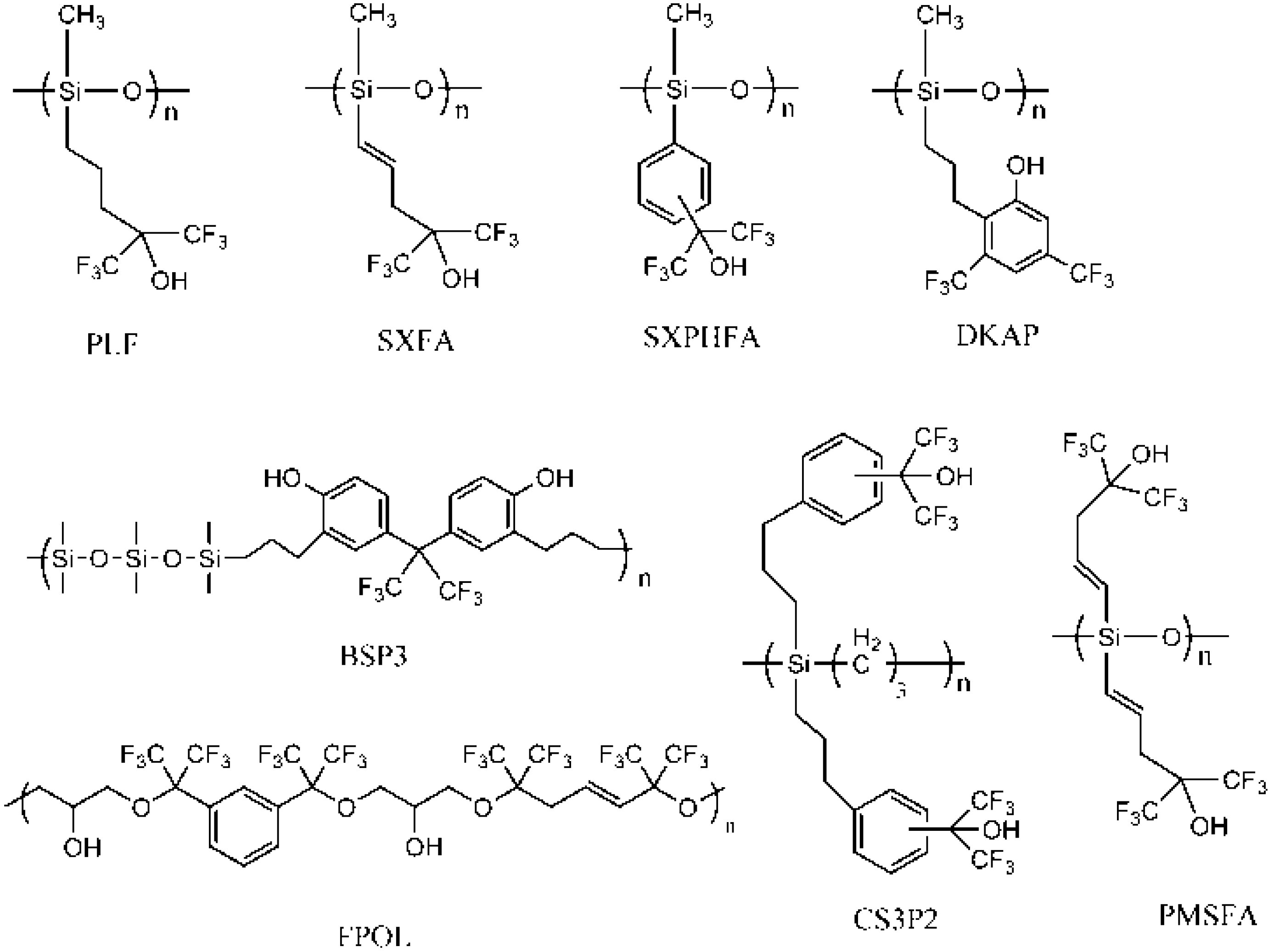
2. Experimental Section
3. Results and Discussion
3.1. Responses to DMMP and Sarin

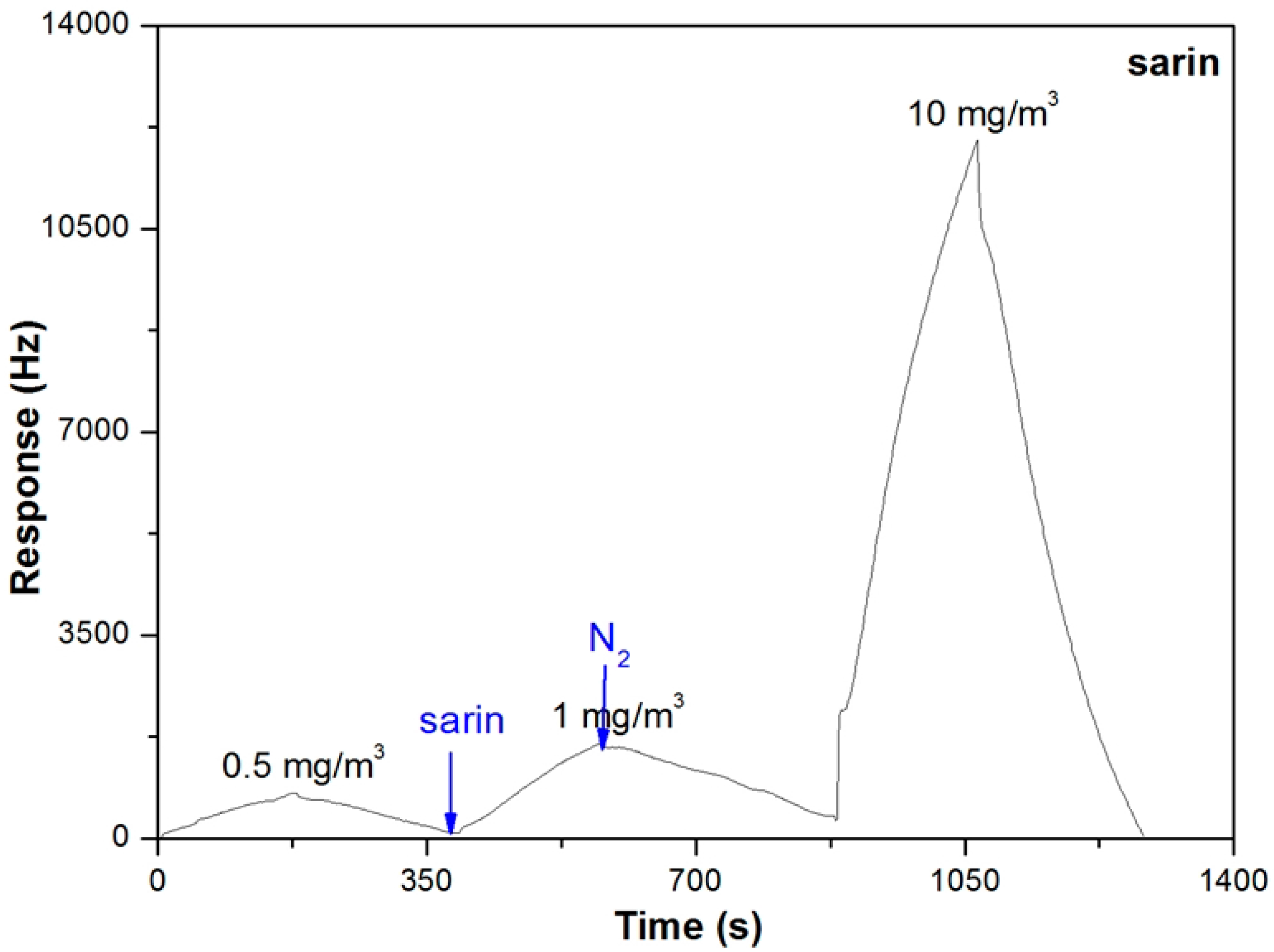
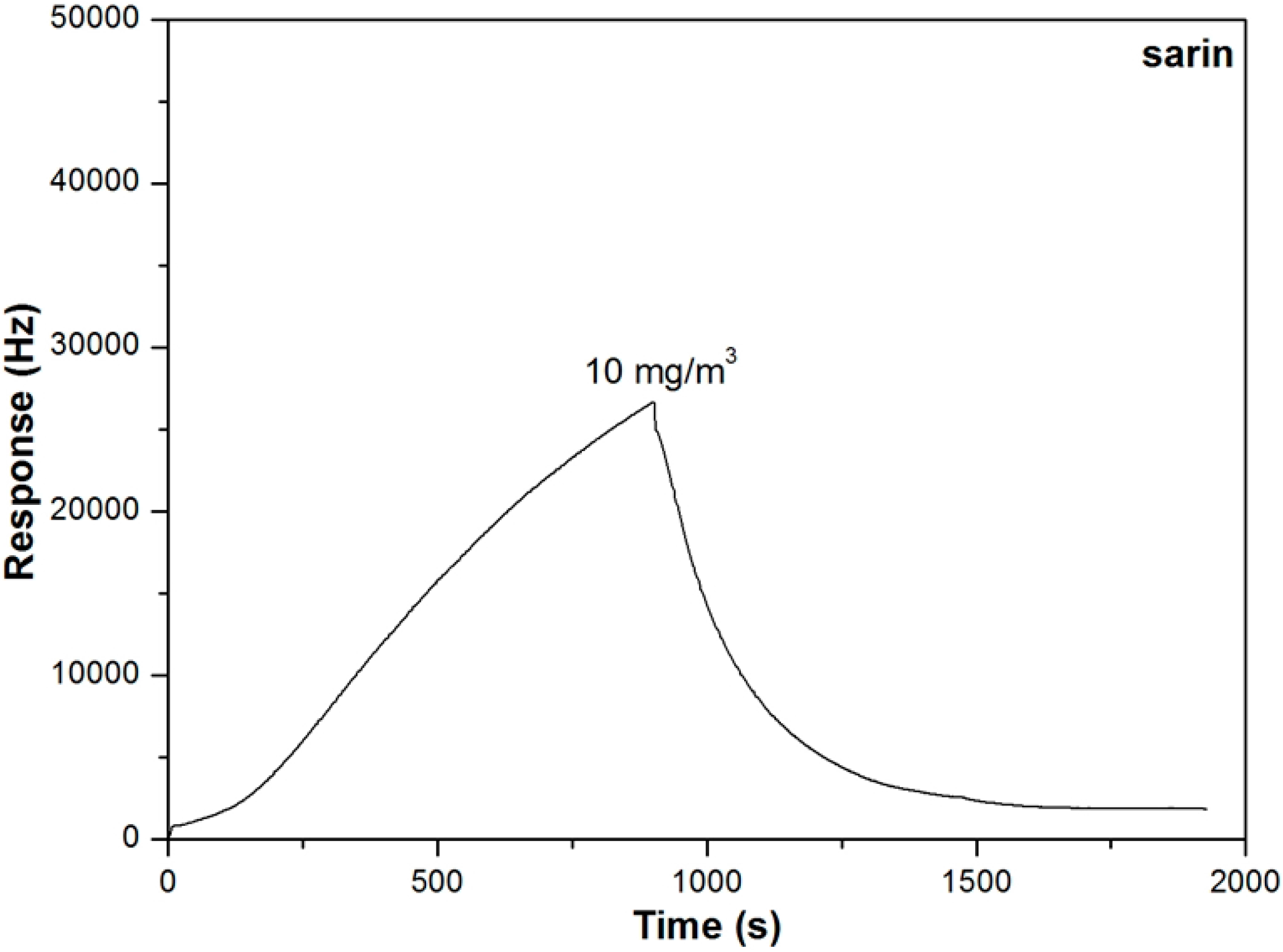
3.2. Responses to 2-CEES, DCP and HD
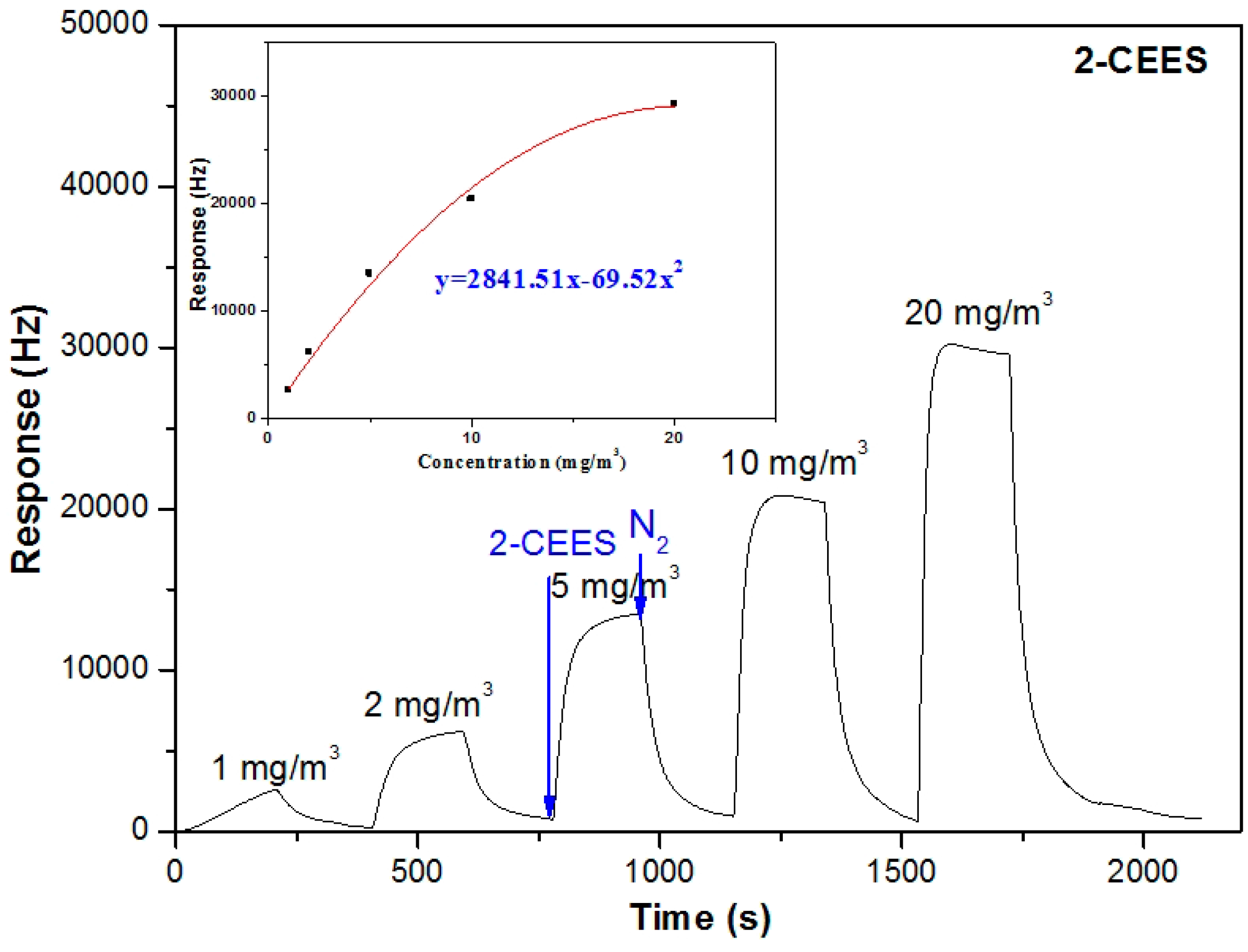
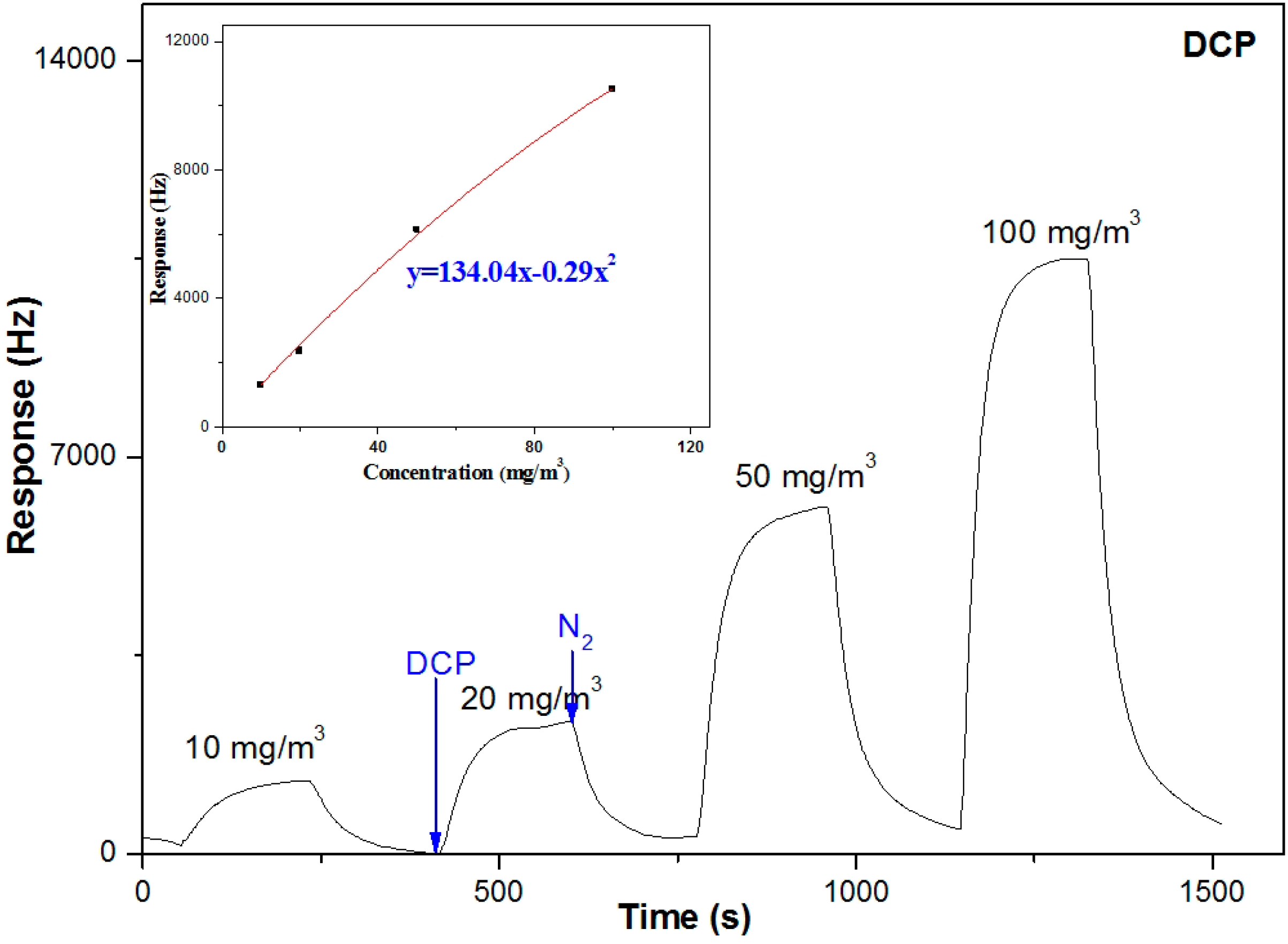

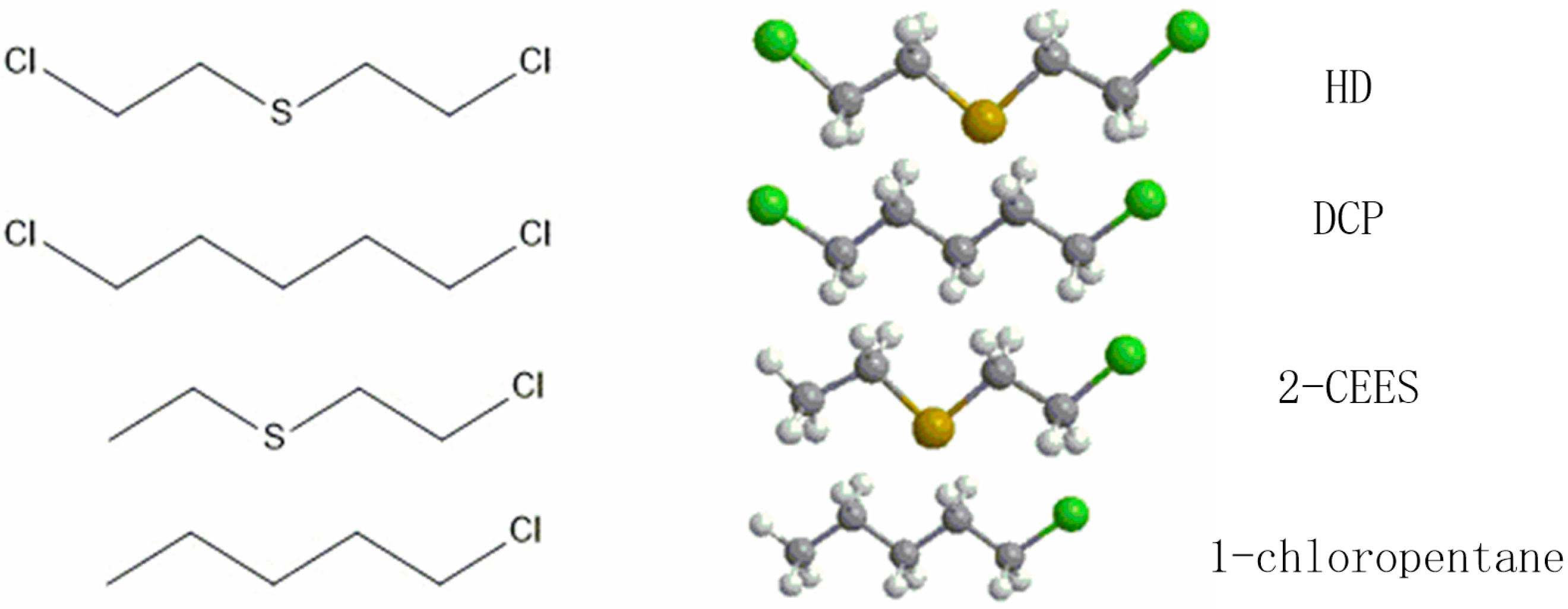
3.3. Responses to Interfering Vapors
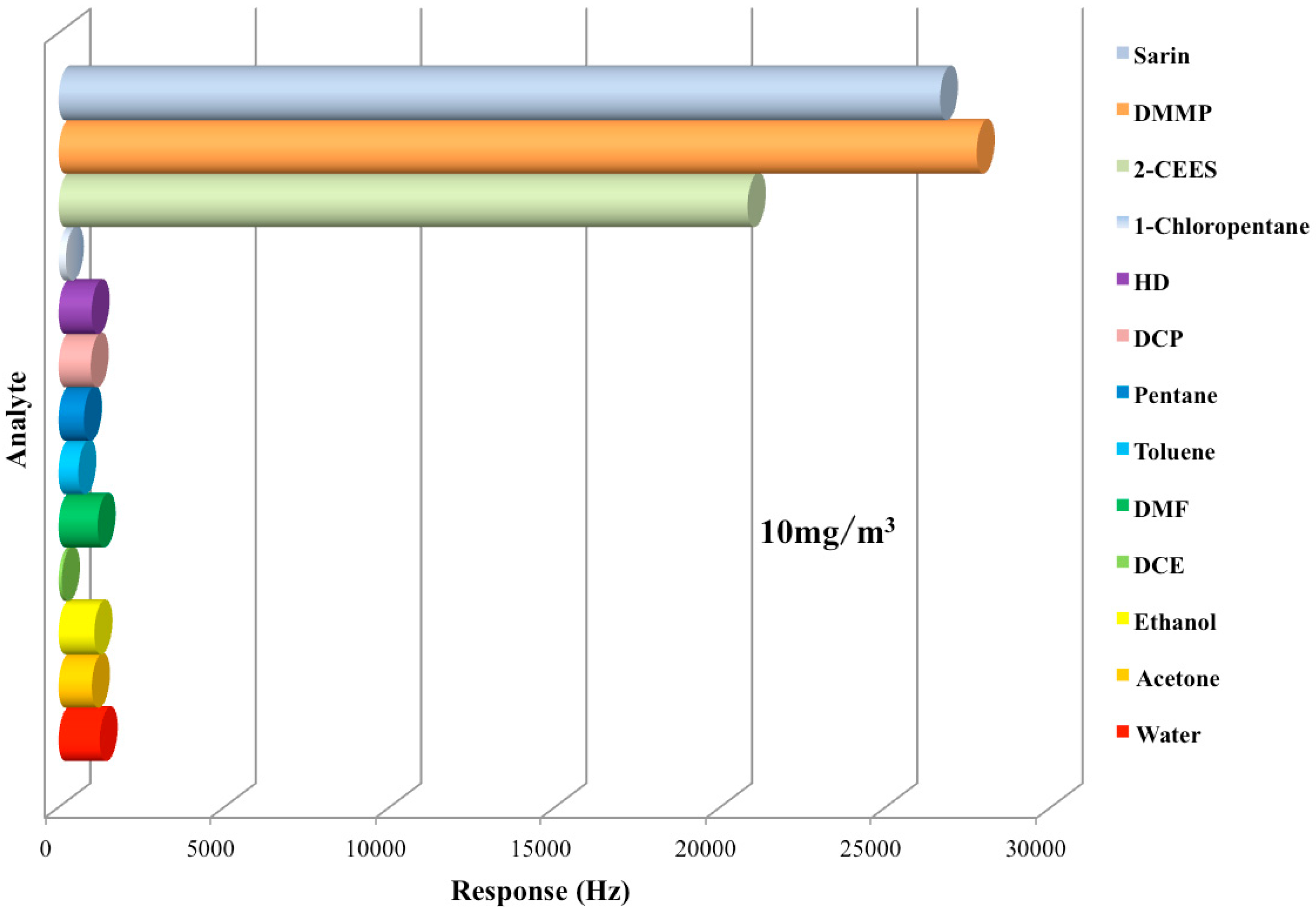
| Acetone | Ethanol | DCE | DMF | Toluene | Pentane | DCP | ||
| Response (Hz) | test 1 | 998 | 1059 | 99 | 1165 | 582 | 767 | 951 |
| test 2 | 1011 | 1089 | 103 | 1184 | 599 | 759 | 975 | |
| test 3 | 1006 | 1081 | 98 | 1178 | 596 | 765 | 969 | |
| Pressure at 25 ℃ (mmHg) | 224.8 | 58.4 | 99.9 | 5.5 | 31.5 | 512.8 | 1.1 | |
| HD | 1-chloro-pentane | 2-CEES | DMMP | Sarin | ||||
| Response (Hz) | test 1 | 996 | 209 | 20754 | 27642 | 26601 | ||
| test 2 | 991 | 213 | 20791 | 27706 | 26655 | |||
| test 3 | 997 | 217 | 20837 | 27761 | 26651 | |||
| Pressure at 25 ℃ (mmHg) | 0.1 | 30.04 | 3.4 | 0.833 | 0.4 | |||
3.4. Sensitive Mechanism
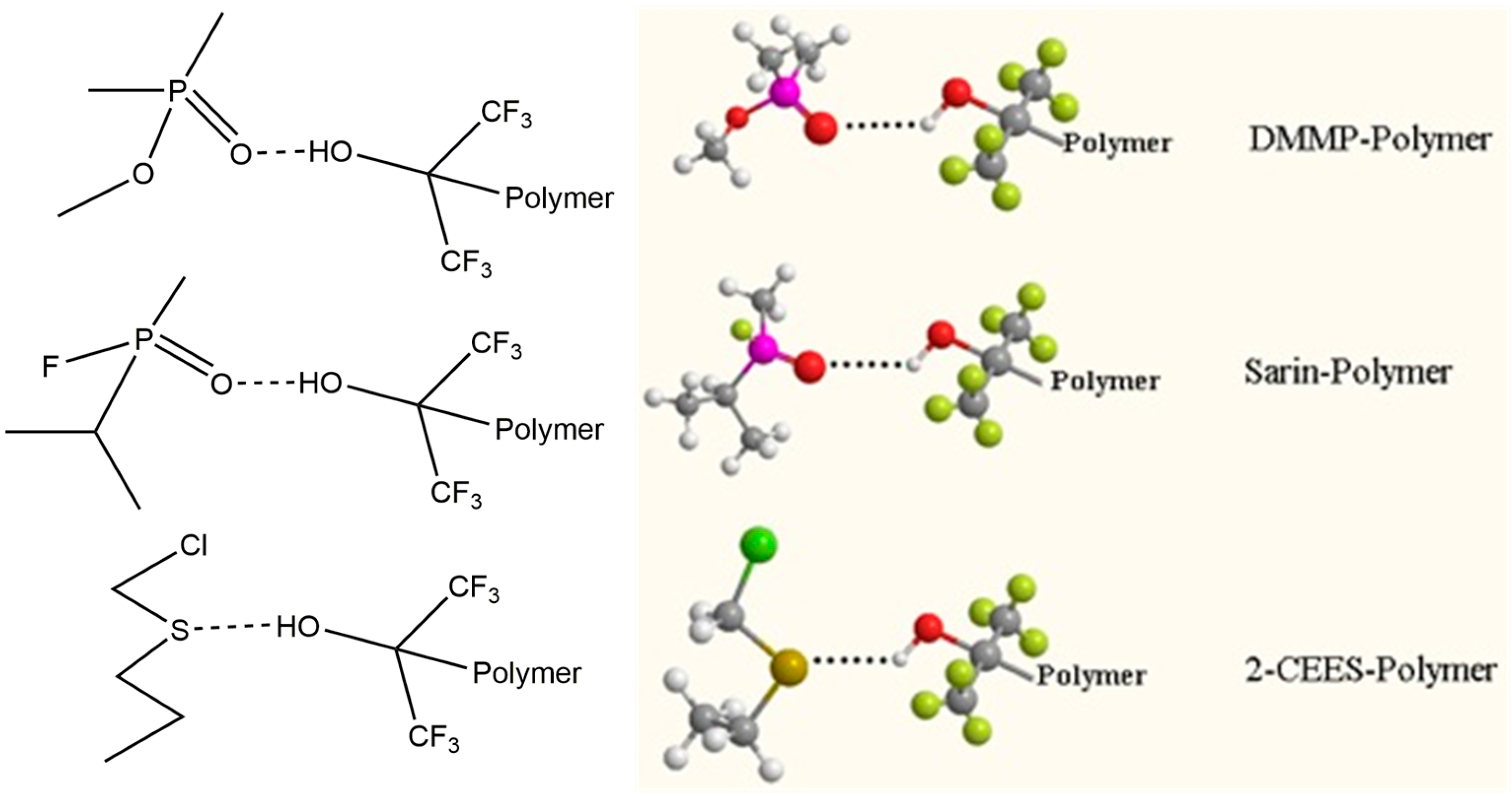
4. Conclusions
Acknowledgments
Author Contributions
Conflicts of Interest
References
- Grate, J.W. Acoustic wave microsensor arrays for vapor sensing. Chem. Rev. 2000, 100, 2627–2648. [Google Scholar] [CrossRef] [PubMed]
- Wang, Y.; Du, X. The response comparison of a hydrogen-bond acidic polymer to sarin, soman and dimethyl methyl phosphonate based on a surface acoustic wave sensor. Anal. Methods 2014, 6, 1951–1955. [Google Scholar] [CrossRef]
- Grate, J.W. Hydrogen-bond acidic polymers for chemical vapor sensing. Chem. Rev. 2008, 108, 726–745. [Google Scholar] [CrossRef] [PubMed]
- Hartmann-Thompson, C.; Hu, J. Hydrogen-bond acidic hyperbranched polymers for surface acoustic wave (SAW) sensors. Chem. Mater. 2004, 25, 5357–5364. [Google Scholar] [CrossRef]
- Hartmann-Thompson, C.; Keeley, D.L. Hydrogen-bond acidic polyhedral oligosilsesquioxane filled polymer coatings for surface acoustic wave sensors. J. Appl. Polym. Sci. 2007, 104, 3171–3182. [Google Scholar] [CrossRef]
- He, W.; Liu, Z. Analytical application of poly{methyl[3-(2-hydroxy-3,4-difluoro)phenyl] propyl siloxane} as a QCM coating for DMMP detection. Talanta 2008, 76, 698–702. [Google Scholar] [CrossRef] [PubMed]
- Wang, F.; Gu, H. Carbon nanotube/polythiophene chemiresistive sensors for chemical warfare agents. J. Am. Chem. Soc. 2008, 130, 5392–5393. [Google Scholar] [CrossRef] [PubMed]
- Fifield, L.S.; Grate, J.W. Hydrogen-bond acidic functionalized carbon nanotubes (CNTs) with covalently-bound hexafluoroisopropanol groups. Carbon 2010, 48, 2085–2088. [Google Scholar] [CrossRef]
- Mäkinen, M.A.; Anttalainen, O.A. Ion mobility spectrometry and its applications in detection of chemical warfare agents. Anal. Chem. 2010, 82, 9594–9600. [Google Scholar] [CrossRef] [PubMed]
- Li, Y.; Du, X. Improvement of column efficiency in MEMS-based gas chromatography column. RSC Adv. 2014, 4, 3742–3747. [Google Scholar] [CrossRef]
- Goswami, S.; Manna, A. Rapid “naked eye” response of DCP, a nerve agent simulant: From molecules to low-cost devices for both liquid and vapour phase detection. RSC Adv. 2014, 4, 21984–21988. [Google Scholar] [CrossRef]
- Saravanan, N.P.; Venugopalan, S. Voltammetric determination of nitroaromatic and nitramine explosives contamination in soil. Talanta 2006, 69, 656–662. [Google Scholar] [CrossRef] [PubMed]
- Mullen, C.; Irwin, A. Detection of explosives and explosives-related compounds by single photon laser ionization time-of-flight mass spectrometry. Anal. Chem. 2006, 78, 3807–3814. [Google Scholar] [CrossRef] [PubMed]
- Bonnot, K.; Bernhardt, P. Tunable generation and adsorption of energetic compounds in the vapor phase at trace levels: A tool for testing and developing sensitive and selective substrates for explosive detection. Anal. Chem. 2010, 82, 3389–3393. [Google Scholar] [CrossRef] [PubMed]
- Das, S.; Chatterjee, D.P. Thermo and pH responsive water soluble polythiophene graft copolymer showing logic operation and nitroaromatic sensing. RSC Adv. 2013, 3, 17540–17550. [Google Scholar] [CrossRef]
- Rabbany, S.Y.; Lane, W.J. Trace detection of explosives using a membrane-based displacement immunoassay. J. Immunol. Methods 2000, 246, 69–77. [Google Scholar] [CrossRef]
- Houser, E.J.; Mlsna, T.E. Rational materials design of sorbent coatings for explosives: Applications with chemical sensors. Talanta 2001, 54, 469–485. [Google Scholar] [CrossRef]
- McGill, R.A.; Stepnowski, J. The design of functionalized silicone polymers for chemical sensor detection of nitroaromatic compounds. Sens. Actuators B Chem. 2000, 65, 5–9. [Google Scholar] [CrossRef]
- Zhang, G.Z.; Zellers, E.T. Portable instrument employing a surface acoustic wave sensor with a regenerable reagent coating for direct measurement of 1,3-butadiene and styrene. Rev. Sci. Instrum. 1995, 66, 239–246. [Google Scholar] [CrossRef]
- Rowe, M.P.; Steinecker, W.H. Exploiting charge-transfer complexation for selective measurement of gas-phase olefins with nanoparticle-coated chemiresistors. Anal. Chem. 2007, 79, 1164–1172. [Google Scholar] [CrossRef] [PubMed]
- Tsai, C.J.; Chen, M.L. Single SnO2 gas sensor as a practical tool for evaluating the efficiency of odor control engineering at food waste composting plants. Sens. Actuators B Chem. 2012, 169, 248–254. [Google Scholar] [CrossRef]
- Mochalski, P.; Wzorek, B. Improved pre-concentration and detection methods for volatile sulphur breath constitutes. J. Chromatogr. B 2009, 877, 1856–1866. [Google Scholar] [CrossRef] [PubMed]
- Chen, Q.F.; Milburn, R.K. Real time monitoring of hazardous airborne chemicals: A styrene investigation. J. Hazard. Mater. 2006, 132, 261–268. [Google Scholar] [CrossRef] [PubMed]
- Hierlemann, A.; Zellers, E.T. Use of linear solvation energy relationships for modeling responses from polymer-coated acoustic-wave vapor sensors. Anal. Chem. 2001, 73, 3458–3466. [Google Scholar] [CrossRef] [PubMed]
- Du, D.; Wang, J. Biomonitoring of organophosphorus agent exposure by reactivation of cholinesterase enzyme based on carbon nanotube-enhanced flow-injection amperometric detection. Anal. Chem. 2009, 81, 9314–9320. [Google Scholar] [CrossRef] [PubMed]
- Du, X.; Ying, Z. Synthesis and evaluation of a new polysiloxane as SAW sensor coatings for DMMP detection. Sens. Actuators B Chem. 2008, 134, 409–413. [Google Scholar] [CrossRef]
- Du, X.; Wang, Z. A new polysiloxane coating on QCM sensor for DMMP vapor detection. J. Mater. Sci. 2009, 44, 5872–5876. [Google Scholar] [CrossRef]
- Huang, J.; Jiang, Y. A new siloxane polymer for chemical vapor sensor. Sens. Actuators B Chem. 2010, 146, 388–394. [Google Scholar] [CrossRef]
- Grate, J.W.; Kaganove, S.N. Hybrid organic/inorganic copolymers with strongly hydrogen-bond acidic properties for acoustic wave and optical sensors. Chem. Mater. 1997, 9, 1201–1207. [Google Scholar] [CrossRef]
- Krech, J.H.; Rose-Pehrsson, S.L. Detection of volatile organic compounds in the vapor phase using solvatochromic dye-doped polymers. Anal. Chim. Acta 1997, 341, 53–62. [Google Scholar] [CrossRef]
- Johnson, S.R.; Sutter, J.M. Identification of multiple analytes using an optical sensor array and pattern recognition neural networks. Anal. Chem. 1997, 69, 4641–4648. [Google Scholar] [CrossRef]
- Albert, K.J.; Gill, S.D. Automatic decoding of sensor types within randomly ordered, high-density optical sensor arrays. Anal. Bioanal. Chem. 2002, 373, 792–802. [Google Scholar] [CrossRef] [PubMed]
- White, J.; Kauer, J.S. Rapid analyte recognition in a device based on optical sensors and the olfactory system. Anal. Chem. 1996, 68, 2191–2202. [Google Scholar] [CrossRef] [PubMed]
- Demathieu, C.; Chehimi, M.M. Inverse gas chromatographic characterization of functionalized polysiloxanes. Relevance to sensors technology. Sens. Actuators B Chem. 2000, 62, 1–7. [Google Scholar] [CrossRef]
- Zimmermann, C.; Mazein, P. Detection of GB and DMMP vapors by love wave acoustic sensors using strong acidic fluoride polymers. IEEE Sens. J. 2004, 4, 479–488. [Google Scholar] [CrossRef]
- Grate, J.W.; Kaganove, S.N. Comparisons of polymer/gas partition coefficients calculated from responses of thickness shear mode and surface acoustic wave vapor sensors. Anal. Chem. 1998, 70, 199–203. [Google Scholar] [CrossRef] [PubMed]
- Lucklum, R.; Behling, C. Role of mass accumulation and viscoelastic film properties for the response of acoustic-wave-based chemical sensors. Anal. Chem. 1999, 71, 2488–2496. [Google Scholar] [CrossRef] [PubMed]
- Wang, Y.; Du, X. Detection of 2,4-dinitrotoluene using hydrogen-bond acidic polymer coated SAW sensor. Chin. Sci. Bull. 2014, 59, 2608–2612. [Google Scholar] [CrossRef]
- Raber, E.; Jin, A. Decontamination issues for chemical and biological warfare agents: How clean is clean enough? Int. J. Environ. Health Res. 2001, 11, 128–148. [Google Scholar] [CrossRef] [PubMed]
- Patil, L.A.; Deo, V.V. Sensing of 2-chloroethyl ethyl sulfide (2-CEES)-a CWA simulant-using pure and platinum doped nanostructured CdSnO3 thin films prepared from ultrasonic spray pyrolysis technique. Sens. Actuators B Chem. 2011, 160, 234–243. [Google Scholar] [CrossRef]
- Patil, L.A.; Deo, V.V. Improved 2-CEES sensing performance of spray pyrolized Ru-CdSnO3 nanostructured thin films. Sens. Actuators B Chem. 2014, 191, 130–136. [Google Scholar] [CrossRef]
- Tomchenko, A.A.; Harmer, G.P. Detection of chemical warfare agents using nanostructured metal oxide sensors. Sens. Actuators B Chem. 2005, 108, 41–55. [Google Scholar] [CrossRef]
- Zhang, Z.; Fan, J.; Yu, J.; Zheng, S.; Chen, W.; Li, H.; Wang, Z.; Zhang, W. New poly (N,N-Dimethylaminoethyl Methacrylate)/polyvinyl alcohol copolymer coated QCM sensor for interaction with CWA simulants. J. ACS Appl. Mater. Interfaces 2012, 4, 944–949. [Google Scholar] [CrossRef] [PubMed]
- Wang, Y.; Du, X. Real-time detection of styrene using SAW sensors based on hexafluoroisopropanol group functionalized hydrogen-bond acidic polymers. Sens. Actuators B Chem. 2015, 206, 272–277. [Google Scholar] [CrossRef]
- Munoz, B.C.; Steinthal, G. Conductive polymer-carbon black composites-based sensor arrays for use in an electronic nose. Sens. Rev. 1999, 19, 300–305. [Google Scholar] [CrossRef]
- Hussain, A.H.M.S.; Yang, H. Investigation of Organosulfur Adsorption Pathways from Liquid Fuels onto Ag/TiOx–Al2O3 Adsorbents at Ambient Conditions. Energy Fuel 2013, 27, 4353–4362. [Google Scholar] [CrossRef]
© 2015 by the authors; licensee MDPI, Basel, Switzerland. This article is an open access article distributed under the terms and conditions of the Creative Commons Attribution license (http://creativecommons.org/licenses/by/4.0/).
Share and Cite
Long, Y.; Wang, Y.; Du, X.; Cheng, L.; Wu, P.; Jiang, Y. The Different Sensitive Behaviors of a Hydrogen-Bond Acidic Polymer-Coated SAW Sensor for Chemical Warfare Agents and Their Simulants. Sensors 2015, 15, 18302-18314. https://doi.org/10.3390/s150818302
Long Y, Wang Y, Du X, Cheng L, Wu P, Jiang Y. The Different Sensitive Behaviors of a Hydrogen-Bond Acidic Polymer-Coated SAW Sensor for Chemical Warfare Agents and Their Simulants. Sensors. 2015; 15(8):18302-18314. https://doi.org/10.3390/s150818302
Chicago/Turabian StyleLong, Yin, Yang Wang, Xiaosong Du, Luhua Cheng, Penglin Wu, and Yadong Jiang. 2015. "The Different Sensitive Behaviors of a Hydrogen-Bond Acidic Polymer-Coated SAW Sensor for Chemical Warfare Agents and Their Simulants" Sensors 15, no. 8: 18302-18314. https://doi.org/10.3390/s150818302





